How does the HR/VP represent the EU?
The ever-changing international landscape continuously questions the international balance of power. The current unipolar world system is tested by the rise of China and the increased importance of regional organizations in a globalized world. Countries and regions have to redefine their role and positions. This is especially true for the European Union. The EU has become a major global actor, but its appearance has been at times inconsistent or even contradictory. Therefore, the EU has to clearly determine which role it wants to play in the international arena and who acts upon its behalf.
Institutionally, the post of the EU High Representative and Vice President of the European Commission (HR/VP) was defined in the Treaty on the European Union to represent the Common Foreign and Security Policy to external players. Currently, the post is held by the Spaniard Josep Borrell who followed the Italian Federica Mogherini who ended her term in November 2019. Acknowledging the multi-faceted nature of the EU, it has been quite an ambitious task to unify different national positions on foreign policy and to shape a common EU position.
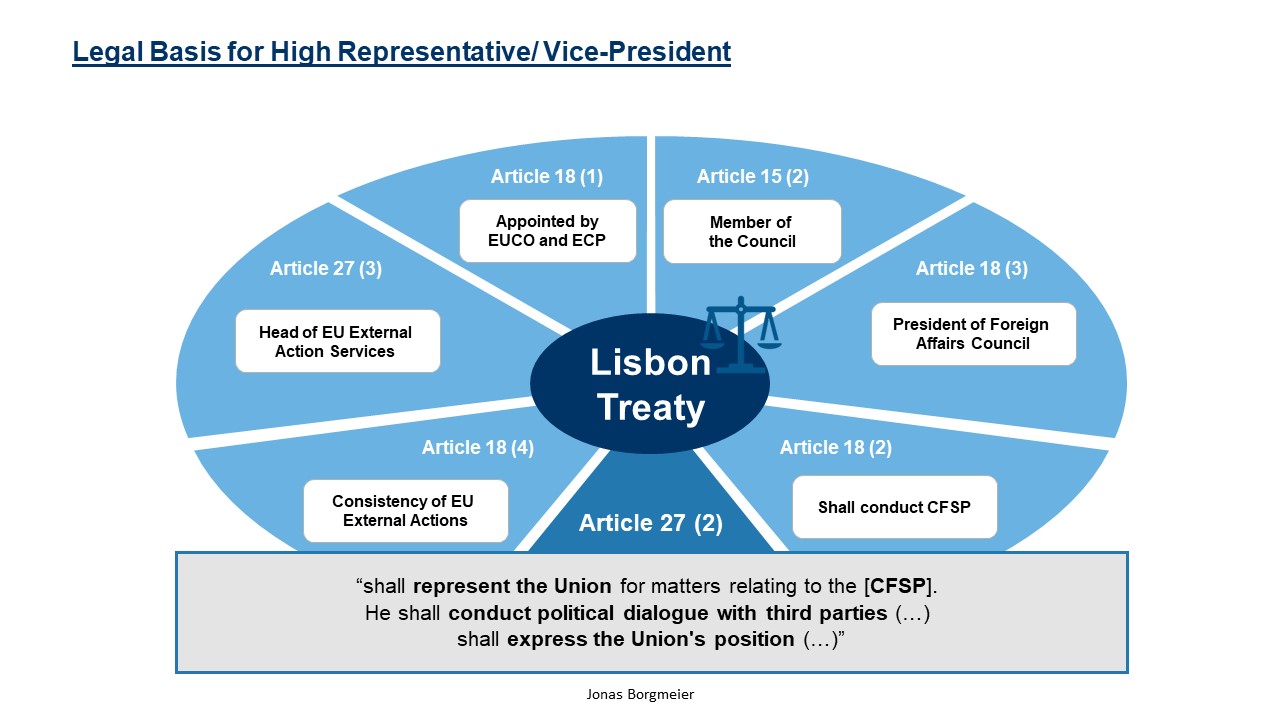
In my Master’s dissertation, I addressed this issue by analyzing the appearance of the EU in the world to make the complexity of EU foreign actions more transparent. This is crucial to understand the current state of affairs to develop coordinated and coherent actions in the future. Travel diplomacy serves as an indicator to measure the EU representation because it makes reflects foreign policy priorities. Aside from the HR/VP, a variety of member state actors represent the EU.
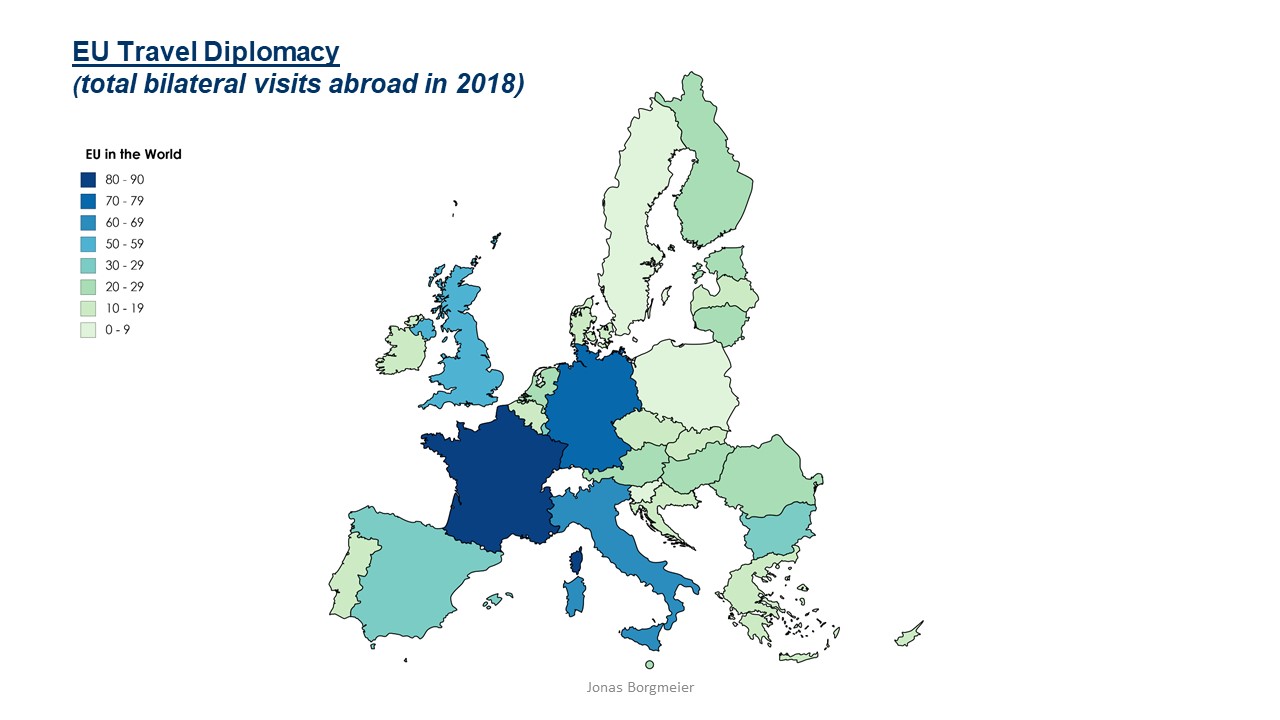
My research is based on primary travel data which was gathered by analyzing the official calendars published on the respective official websites. It contains any visit fulfilling the criteria of taking place in the interlocutor’s home country, being outside of the EU and being exclusively bilateral. The data sample includes the travel activity of the HR/VP as well as of the Heads of Government and Foreign Ministers of six defined member states. The latter were chosen because of their high travel frequency in the first place but also considered geographical and demographical diversity. Consequently, Bulgaria, Estonia, France, Germany, Italy and Spain were subject to data gathering. The data included among others the regional location of a country, the position of the host as well as the content of the meetings.
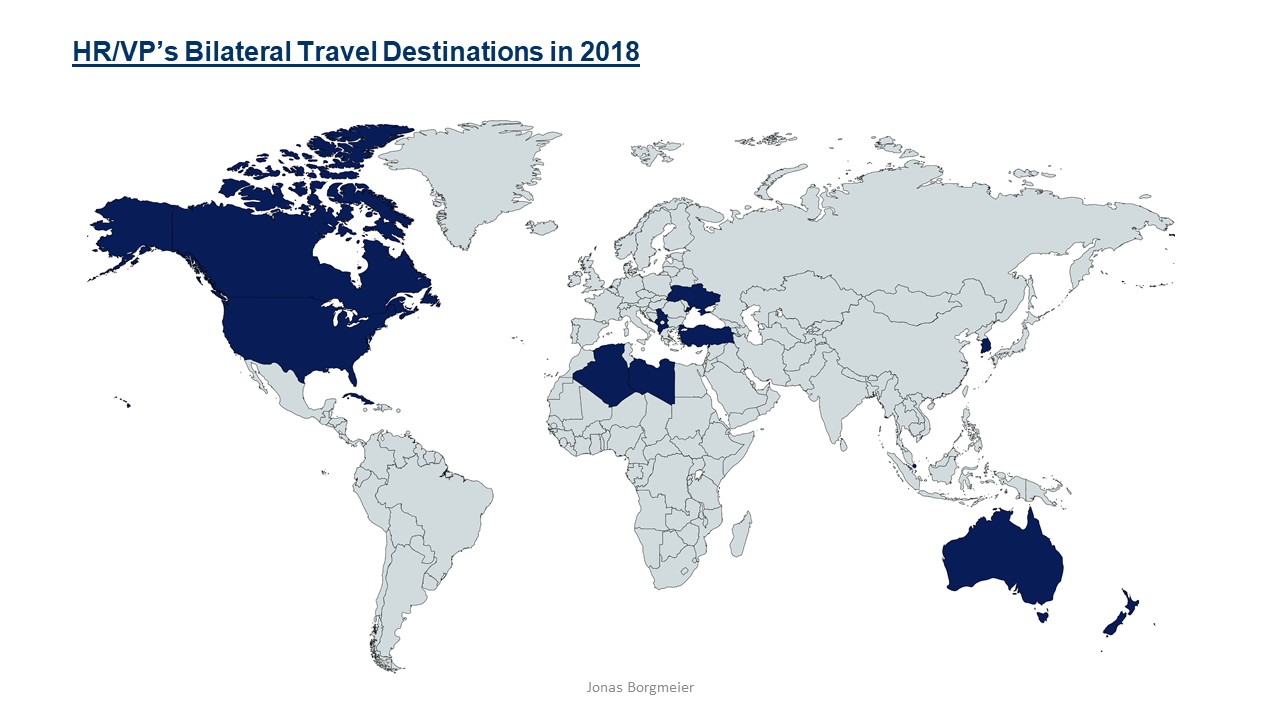
I conducted two analytical steps. First, the bilateral travel diplomacy of the HR/VP was investigated as an individual case. It included the inquiry of the travel profile as well as matching it with the defined CFSP priorities. Second, a comparative case analysis encompassed the one-to-one match of the HR/VP with a member state representative. Each individual analysis followed a similar three-dimensional structure encompassing the assessment of geographical indicators such as the number and frequency of visited countries as well as their regional location. Further, two hierarchical indicators were investigated. The position of the highest-ranked host as well as the G20-member status of a state were interpreted. Finally, the content of the meetings was categorized and subsequently the distribution of priorities was interpreted.
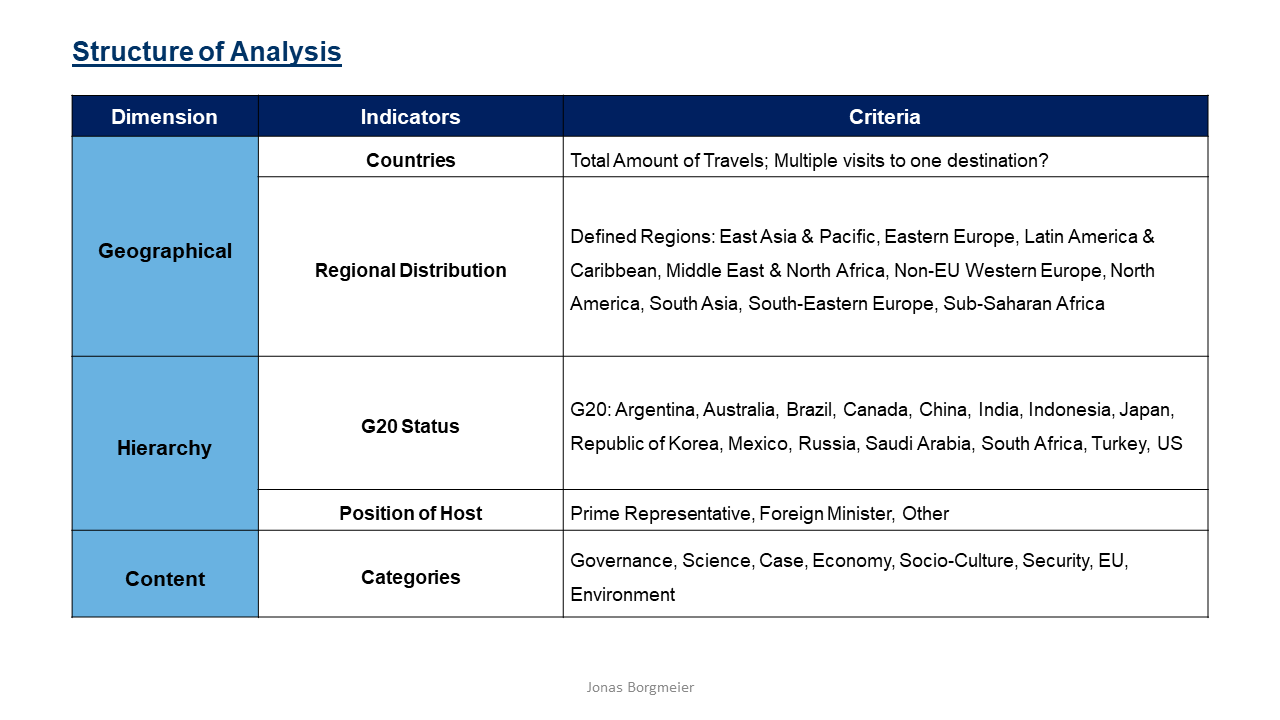
Based on the individual case analysis of the HR/VP, each member state representative was subject to inquiry and compared to the HR/VP. By calculating the Bravais-Pearson Correlation Coefficient of the HR/VP profile and the individual member state actor’s profile, the identified similarities and differences became measurable. The correlation coefficients were ranked according to their degree of positive correlation to negative correlation with the HR/VP. This was conducted for the regional, hierarchical as well as content dimension. Finally, the results of these analyses were translated into nine key findings about the nature of EU travel diplomacy which will be introduced and contextualized in the following.
1. The HR/VP uses bilateral travel diplomacy to focus on the EU-relations with countries in the South-Eastern EU neighborhood.
This statement reflects the HR/VP’s geographical emphasis on the region. The largest share of her travels was destined to countries in South-Eastern Europe. Federica Mogherini discussed different EU-Membership scenarios for Western Balkan states. For example, she urged for reforms in governance and actively supported the name-change-referendum in North-Macedonia, both being important steps on the path towards EU-Membership. Based on this, I argue that the HR/VP uses travel diplomacy to engage with candidate countries.
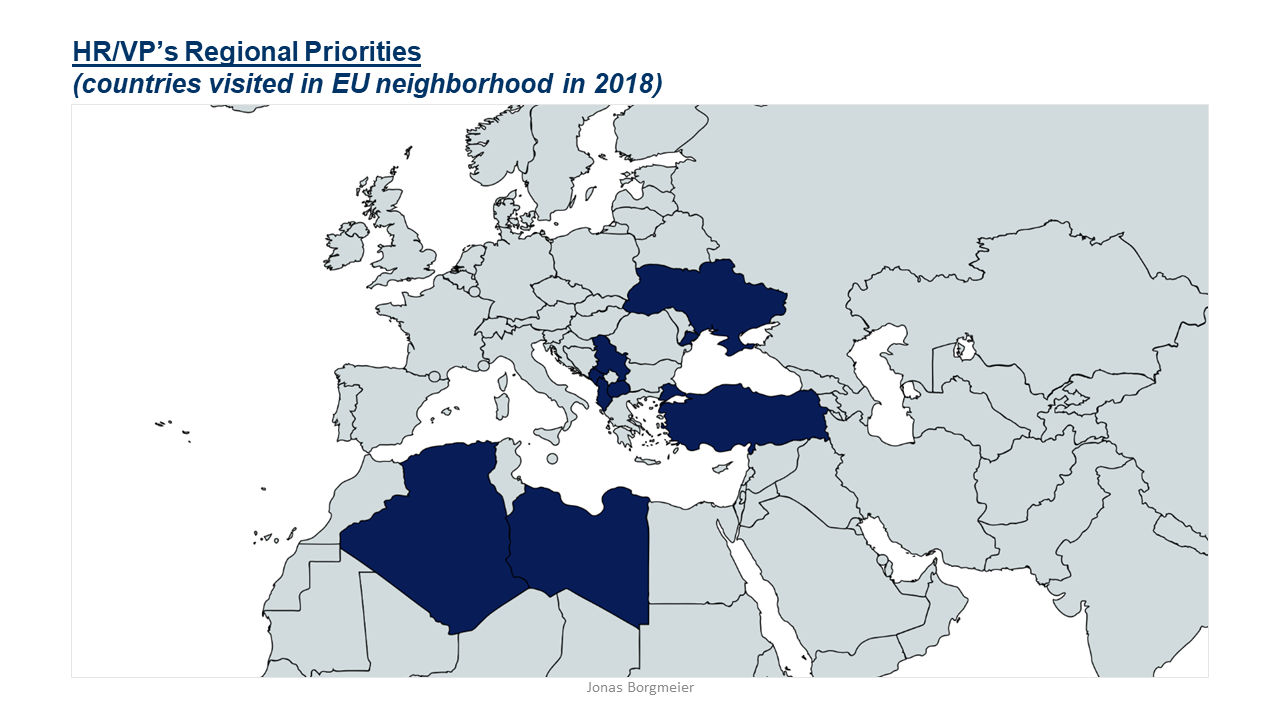
2. The HR/VP uses bilateral travel diplomacy to manage crisis situations in the EU neighborhood.
In 2018, the HR/VP visited Ukraine to discuss the Crimean Conflict and travelled to Libya to support the political and developing processes. Furthermore, Mogherini travelled to Turkey where she also addressed the challenging migration flows. She appeared to be a crisis manager taking country-specific, regional as well as security and governance matters into account.
3. The HR/VP uses bilateral travel diplomacy to foster EU-relations with medium-sized powers.
In a quarter of travels, the HR/VP was welcomed by a high-level politician in a G20 country. These encompassed Australia, Canada, Korea and Turkey, which are arguably medium-sized countries. The HR/VP emphasized the comprehensive bilateral partnership with the EU and initiated further collaboration. For example, this included the deepening of the strategic partnership with Canada and Korea as well as the implementation of the Framework Agreements with Australia .
4. The HR/VP generally fulfills her country-specific mandate during her visits.
Contrasting the content of the travel missions with her mandate, the HR/VP mostly met the identified country-specific priorities set by the CFSP Annual Report 2017 a share of 79%. This calculation is based on the analysis of the country-specific Common Foreign and Security Policy priorities being matched with the travel diplomacy of the HR/VP. For instance, Mogherini succeeded in communicating the need for reforms in the Western Balkan states and offered opportunities for a closer and more constructive partnership with Cuba .
5. The HR/VP has an almost exclusive geographical focus that complements most EU member states.
In comparison to the HR/VP, the majority of national representatives had negligible correlation coefficient values which point to almost no correlation. This can be partly explained by the fact that the HR/VP put a lot of emphasis on South-Eastern Europe whereas others travelled to Latin America & Caribbean or Sub-Saharan Africa more frequently while Mogherini rather disregarded those regions.
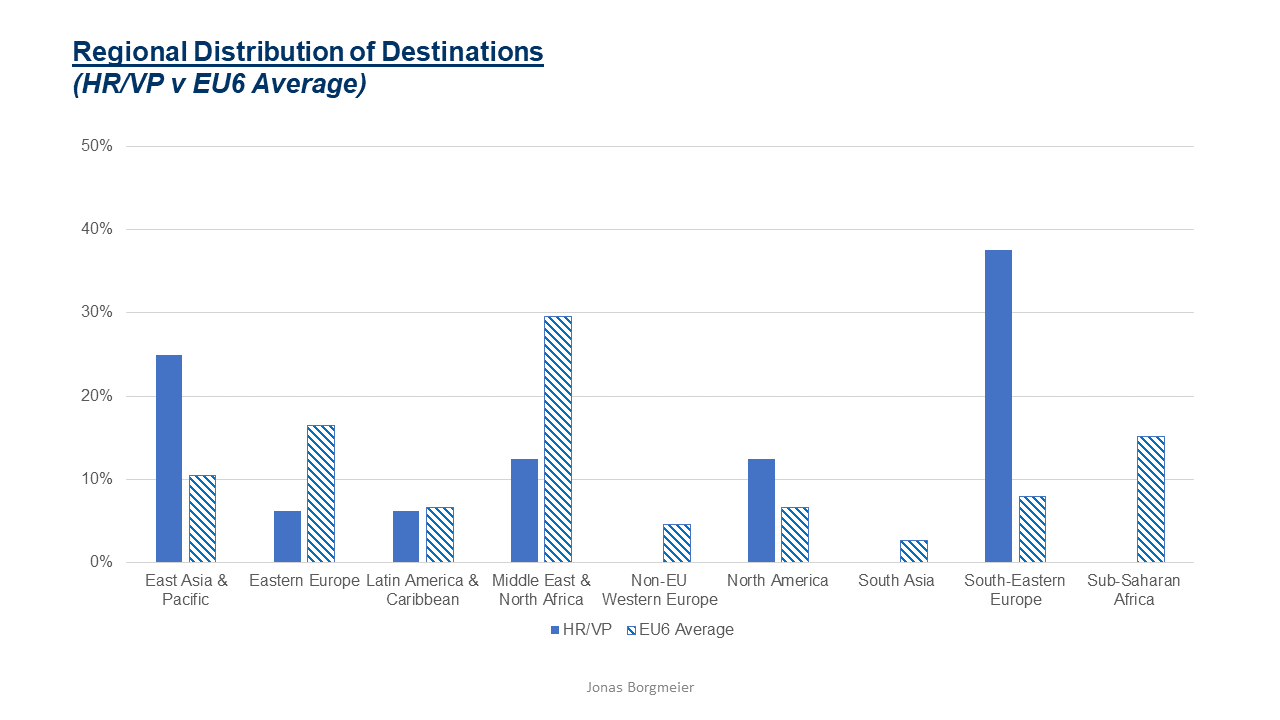
6. The hierarchical position of the HR/VP is perceived like an average member state representative by the host countries.
Comparing the distribution of travels among G20 and Non-G20 countries as well as the hierarchical position of the highest-ranked host, it is noticeable that the HR/VP and most member state representatives had a very similar profile.
7. The HR/VP addresses similar topics like big EU member states.
This statement can be justified by the correlation coefficient being calculated on the basis of how often different content categories were covered in the talks. It has been analyzed that the agenda of Italian, German and French representatives had the most positive correlation with the HR/VP’s priorities. The Italian Head of Government (HoG) has a rather similar profile while the Estonian HoG emphasizes differing topics. This leaves room for speculation about the dominance of big EU members influencing the HR/VP agenda.
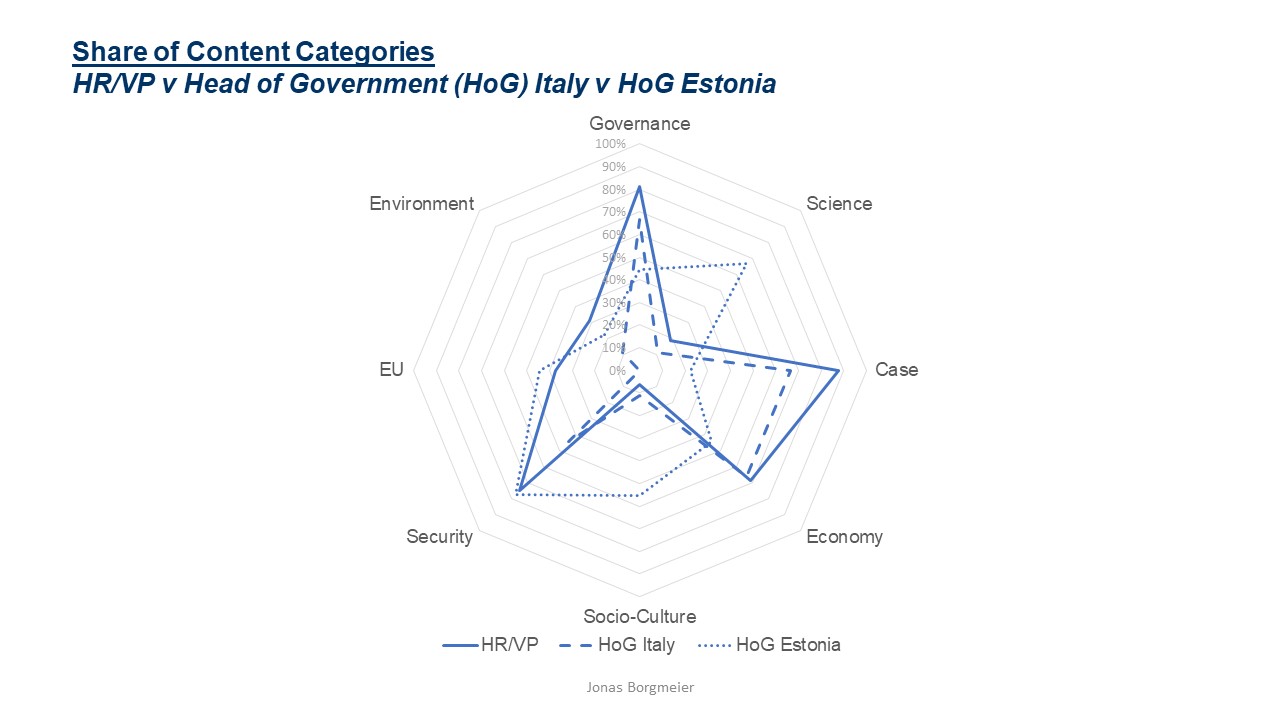
8. The HR/VP’s agenda priorities are more similar to a Foreign Minister than to a Head of Government.
The data analysis has shown that the HR/VP content profile correlates more positively with the average Foreign Minister. It may be considered that there were certain similarities with both national actors – Heads of Governments and Foreign Ministers. The common relatively low prioritization of socio-cultural and science-related issues may explain the divergences expressed through the higher value of the correlation coefficient of the average Foreign Minister.
9. The HR/VP acts uniquely in comparison to individual member state actors.
The HR/VP has shown a unique regional profile putting a strong emphasis on South-Eastern Europe as well as visiting two countries exclusively. Furthermore, on the content-level, the HR/VP put special emphasis on governance as well as case and security issues while national actors generally had a more extended agenda and also emphasized economic and socio-cultural relations more frequently.
Reflecting upon these results, I argue that the role of the HR/VP needs to be further strengthened to represent the EU with a coherent and strong voice in the international arena. My work has shown that the HR/VP has used travel diplomacy to engage in the EU neighborhood as well as with medium-sized powers. However, I believe a true High Representative also needs to meet high-profile politicians from powerful countries such as China, Russia and the US. This requires further integration in the field of EU foreign policy. One path of reaching this aim certainly includes the introduction of quality majority voting in CFSP matters. I am convinced that this will benefit the EU as a whole including rather Euroskeptic national governments. Coherent representation and a single voice make the EU more credible, reliable and powerful in the ever-changing international arena.
Thank you for investing your time in reading this post. If you have feedback, questions or concerns, feel free to reach out to me on twitter.